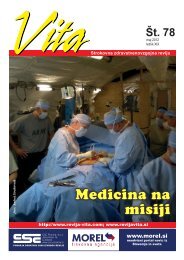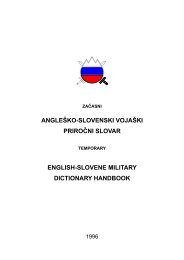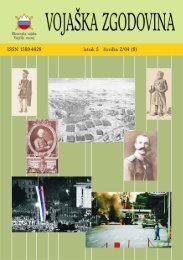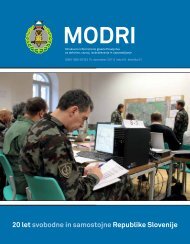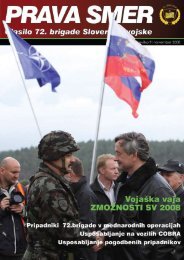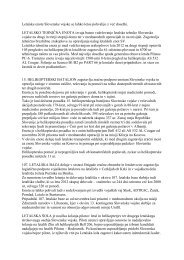Letnik 9/2, september 2007 - Slovenska vojska
Letnik 9/2, september 2007 - Slovenska vojska
Letnik 9/2, september 2007 - Slovenska vojska
Create successful ePaper yourself
Turn your PDF publications into a flip-book with our unique Google optimized e-Paper software.
Andrew Nichols Pratt<br />
was still brought up in a life of heady privilege. Like most of his companions, Bin<br />
Laden was spoiled, sexually frustrated and bored silly. Although he grew up in the<br />
most fundamentalist and conservative Islamic country in the world, he is reputed to<br />
have enjoyed the nightlife of Beirut. Its famous Kornish district was the real Mecca<br />
for many exasperated desert youths and their “Airport Wahhabi” friends. Even<br />
today, Hamra Street offers alcohol, gratuitous sex, excitement and always a little<br />
violence.<br />
Early on, Bin Laden appeared to be very non-confrontational; however, in 1979,<br />
the year he graduated from King Abdul-Azziz University, the Soviet Union invaded<br />
Afghanistan and the Iranian Revolution began. His life took a radical turn. Bin<br />
Laden was enraged by the Soviet repression of the Afghans and his own country’s<br />
indifference. As with the 1967 Arab-Israeli War and the fall of Jerusalem into<br />
Israeli hands, the Soviet invasion appeared to be yet another in a succession of<br />
divine punishments for those straying from the ordained path of Islam. As we now<br />
know from many sources, Bin Laden spent the next five years raising money and<br />
recruiting ‘volunteers’ to fight against the infidel Soviets.<br />
In an effort to be closer to the action and aid the fighters, he moved to Peshawar<br />
about 1984. His guesthouse, Bait ul’ Ansar, was the first way station of “Arab”<br />
Mujahideen when they came to Afghanistan before going to the front or beginning<br />
training. Bin Laden also crossed into Afghanistan to oversee the delivery of<br />
construction machinery, which he placed at the disposal of the Afghans to dig<br />
tunnels and prepare ordnance storage areas. Bin Laden started spending more<br />
and more time in Afghanistan. Not content as a spectator, he wanted to train<br />
and command his own fighters, thus he created his own unit in order to direct<br />
their battles. His first and last face-to-face encounter with the Soviet army, using<br />
pure Arab personnel, was at Jaji and according to independent accounts, was a<br />
military disaster. 2 What most Westerners do not appreciate is that the real fighters,<br />
the simple, oppressed Afghans, scorned the “Internationalists,” “Wahhabi’s” or<br />
“Arabs” as they were described in casual conversation. To gain a sense of their<br />
cynical contempt, one needs only to read interviews with some of the Mujahideen’s<br />
most successful commanders in The Other Side of the Mountain. The Arabs, for<br />
the most part, enjoyed posing for war pictures, videotaping the “Great Game,”<br />
and generally role-playing. During one particularly sharp engagement on the<br />
Afghan-Pakistan border, an Arab unit was begged to reinforce the beleaguered<br />
2<br />
Marc Sageman, author of “Understanding Terror Network.” Dr. Sageman was a CIA case officer in Pakistan and<br />
had direct contact with the Afghan Mujahidin during the Soviet occupation.<br />
165



